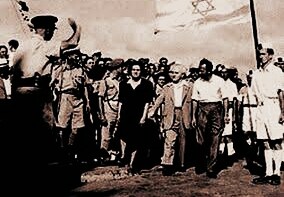After 1945, Britain found itself in fierce conflict with the Jewish community, as the Haganah joined Irgun and Lehi in armed struggle against British rule. At the same time, thousands of Jewish refugees from Europe sought shelter in Palestine and were turned away or rounded up and placed in detention camps by the British. In 1947, the British government withdrew from the Mandate of Palestine, stating it was unable to arrive at a solution acceptable to both Arabs and Jews. The newly created United Nations approved the Partition Plan for Palestine United Nations General Assembly Resolution 181 on November 29, 1947, which sought to divide the country into two states one Arab and one Jewish.
The Jewish community accepted the plan, but the Arab League and Arab Higher Committee rejected it. On December 1, 1947, the Arab Higher Committee proclaimed a three-day strike, and Arab bands began attacking Jewish targets. Jews were initially on the defensive as civil war broke out, but they gradually moved onto the offensive. The Palestinian Arab economy collapsed and 250,000 Palestinian-Arabs fled or were expelled.
On May 14, 1948, the day before the expiration of the British Mandate, the Jewish Agency proclaimed independence, naming the country Israel. The following day, the armies of four Arab countries—Egypt, Syria, Lebanon and Iraq—attacked Israel, launching the 1948 Arab–Israeli War; Saudi Arabia sent a military contingent to operate under Egyptian command; Yemen declared war but did not take military action. After a year of fighting, a ceasefire was declared and temporary borders, known as the Green Line, were established. Jordan annexed what became known as the West Bank and East Jerusalem, and Egypt took control of the Gaza Strip. About 700,000 Palestinian refugees were expelled or fled the country during the conflict.
In the early years of the state, the Labor Zionist movement led by Prime Minister David Ben-Gurion dominated Israeli politics. These years were marked by an influx of Holocaust survivors and Jews from Arab lands, many of whom faced persecution in and expulsion from their original countries. Consequently, the population of Israel rose from 800,000 to two million between 1948 and 1958. Some arrived as refugees with no possessions and were housed in temporary camps known as ma'abarot; by 1952, over 200,000 immigrants were living in these tent cities. The need to solve the crisis led Ben-Gurion to sign a reparations agreement with West Germany that triggered mass protests by Jews angered at the idea of Israel accepting financial compensation from Germany for the Holocaust.
In the 1950s, Israel was frequently attacked by Palestinian fedayeen, mainly from the Egyptian-occupied Gaza Strip. In 1956, Israel joined a secret alliance with Great Britain and France aimed at regaining control of the Suez Canal, which the Egyptians had nationalized (see the Suez Crisis). Israel captured the Sinai Peninsula but was pressured to withdraw by the United States and the Soviet Union in return for guarantees of Israeli shipping rights in the Red Sea and the Canal.


No comments:
Post a Comment